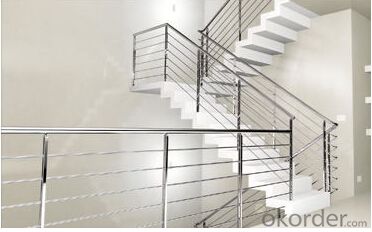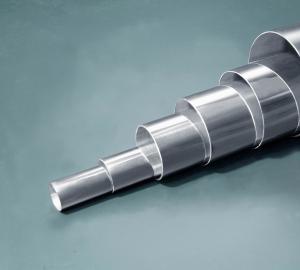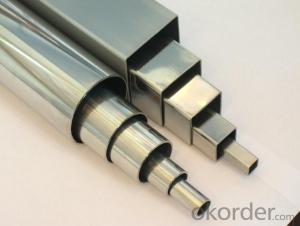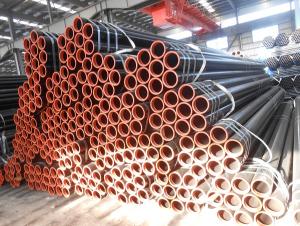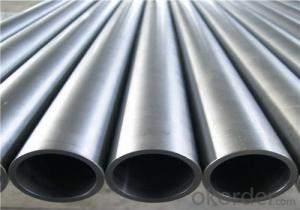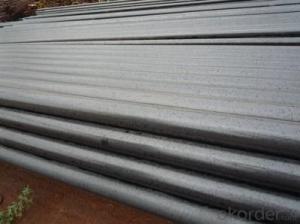Stainles Seamless Steel Pipe 201 /304 /316 /430 used for Oil Pipe Manufacturer
- Loading Port:
- China Main Port
- Payment Terms:
- TT or LC
- Min Order Qty:
- 30 m.t.
- Supply Capability:
- 12000 m.t./month
OKorder Service Pledge
OKorder Financial Service
You Might Also Like
1、Structure of Seamless Pipe ASTM A106/53:
carbon seamless steel pipes are widely used in gas, water and oil, transpotation;constructions;Bridge,highway,windows of model steel door; building materials;fences;heating facilities Fluid Pipe;conduit pipe,scaffolding pipe.etc.
Payment Terms: L/C D/A D/P T/T
Packing and shipment
Packaged in bundles,as per customers' requirements, it can also bepackagesd as beveled ends, typed marking, black painting, plastic caps protection,woven bags packing
For 20" container the max length is 5.8m; For 40" container the max length is 12m. other options are available based on customer requests. Please discuss when placing orders.
2、Main Features of the Seamless Pipe ASTM A106/53:
• High manufacturing accuracy
• High strength
• Small inertia resistance
• Strong heat dissipation ability
• Good visual effect
• Reasonable price
3、Seamless Pipe ASTM A106/53 Specification:
Standard | GB, DIN, ASTM ASTM A106-2006, ASTM A53-2007 |
Grade | 10#-45#, 16Mn 10#, 20#, 45#, 16Mn |
Thickness | 8 - 33 mm |
Section Shape | Round |
Outer Diameter | 133 - 219 mm |
Place of Origin | Shandong, China (Mainland) |
Secondary Or Not | Non-secondary |
Application | Hydraulic Pipe |
Technique | Cold Drawn |
Certification | API |
Surface Treatment | factory state or painted black |
Special Pipe | API Pipe |
Alloy Or Not | Non-alloy |
Length | 5-12M |
Outer Diameter | 21.3-610mm |
Grade | 20#, 45#, Q345, API J55, API K55, API L80, API N80, API P110, A53B |
Standard | ASME, ASTM |
1) Material:20#(ASTM A 106/A53 GRB.API5LGRB,GB),45#,16Mn,10#.
2) Specification range:OD:21.3-610mm,WT:6-70mm,length:6-12m or according to the requirement of clients.
3) Excutive standards:GB,ASME API5L.ASTM A 106/A53,Despite of the above standards,we can also supply seamless steel pipe with standard of DIN,JIS,and so on,and also develop new products according to the requirements of our clients!
4) Surface:black lacquered,varnish coating or galvanized.
5) Ends:Beveled or square cut,plastic capped,painted.
6) Packing:bundles wrapped with strong steel strip,seaworthy packing.
4、Packaging & Delivery
Packaging Details: | seaworthy package,bundles wrapped with strong steel strip |
Delivery Detail: | 15-30days after received 30%TT |
5、FAQ of Seamless Pipe ASTM A106/53:
①How is the quality of your products?
Our products are manufactured strictly according to national and internaional standard, and we take a test
on every pipe before delivered out. If you want see our quality certifications and all kinds of testing report, please just ask us for it.
Guaranteed: If products’ quality don’t accord to discription as we give or the promise before you place order, we promise 100% refund.
②How about price?
Yes, we are factory and be able to give you lowest price below market one, and we have a policy that “ for saving time and absolutely honest business attitude, we quote as lowest as possible for any customer, and discount can be given according to quantity”,if you like bargain and factory price is not low enough as you think, just don’t waste your time.Please trust the quotation we would give you, it is professional one.
③Why should you chose us?
Chose happens because of quality, then price, We can give you both.Additionally, we can also offer professional products inquiry, products knowledge train(for agents), smooth goods delivery, exellent customer solution proposals.Our service formula: good quality+good price+good service=customer’s trust
SGS test is available, customer inspection before shipping is welcome, third party inspection is no problem.
6、Seamless Pipe ASTM A106/53 Images:
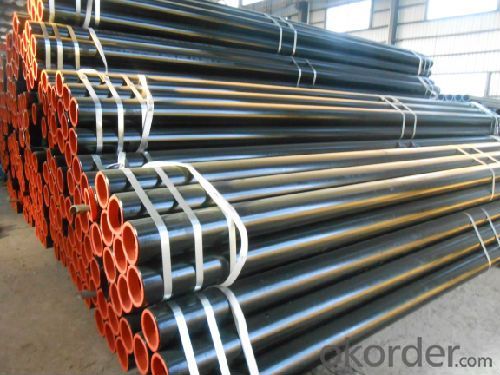
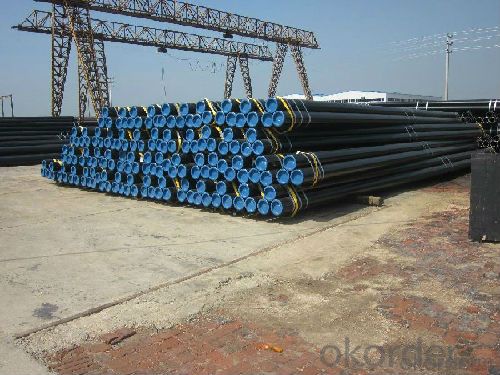
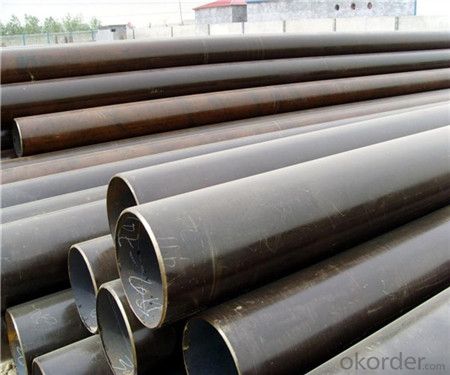
- Q: How do you prevent leakage in stainless steel pipes?
- To prevent leakage in stainless steel pipes, there are several measures that can be taken: 1. Proper installation: Ensure that the stainless steel pipes are installed correctly by trained professionals who have expertise in working with stainless steel. This includes using appropriate fittings, connectors, and seals to ensure a tight and secure connection. 2. Regular inspections: Conduct routine inspections to identify any signs of leakage such as corrosion, cracks, or loose fittings. This allows for proactive maintenance and repairs before a major leak occurs. 3. Use high-quality materials: Choose stainless steel pipes that are made from high-grade materials and comply with industry standards. Low-quality materials or substandard manufacturing can lead to weak spots and increased risk of leakage. 4. Proper sealing: Use effective sealing methods such as gaskets, o-rings, or thread sealants to create a tight seal between pipe joints. This prevents any potential leakage points where fluids or gases can escape. 5. Pressure testing: Conduct pressure tests on the stainless steel pipes to ensure their integrity before they are put into operation. This helps identify any weaknesses or leaks that may have occurred during installation. 6. Regular maintenance: Implement a regular maintenance schedule to inspect and maintain stainless steel pipes. This includes checking for signs of corrosion, replacing worn-out seals or gaskets, and tightening fittings as necessary. 7. Avoid over-tightening: While it is important to ensure a secure connection, over-tightening fittings can lead to stress and damage to the pipe, which can result in leaks. Follow the manufacturer's guidelines for proper tightening torque. 8. Proper pipe support: Ensure that stainless steel pipes are adequately supported and secured to prevent stress or movement that can cause leaks. This includes using appropriate hangers, clamps, or brackets suitable for stainless steel pipes. By following these preventive measures, the likelihood of leakage in stainless steel pipes can be greatly reduced, ensuring the long-term integrity and reliability of the piping system.
- Q: Can stainless steel pipes be used for underground drainage systems?
- Indeed, underground drainage systems can utilize stainless steel pipes. Stainless steel proves to be a robust and corrosion-resistant substance capable of enduring the harsh conditions commonly encountered beneath the surface, encompassing moisture, soil chemicals, and fluctuating temperatures. Furthermore, stainless steel pipes exhibit resistance to rust, a prevalent issue faced by alternative pipe materials. Moreover, their extended lifespan and minimal maintenance demands render stainless steel pipes a fitting selection for underground drainage systems.
- Q: Can stainless steel pipes be used for underground drainage?
- Certainly! Stainless steel pipes are capable of being used for underground drainage. Stainless steel, a material highly resistant to corrosion and extremely durable, is appropriate for a variety of applications, including underground drainage systems. Its exceptional resistance to rust, corrosion, and chemical damage guarantees a lengthy lifespan and low maintenance requirements. Moreover, stainless steel pipes possess great strength and can endure high-pressure conditions, making them ideal for underground drainage where external load or stress may be encountered. In addition, stainless steel pipes are renowned for their smooth inner surface, which aids in preventing blockages and facilitating the efficient flow of water and waste. All in all, stainless steel pipes are a dependable and enduring option for underground drainage systems.
- Q: Can stainless steel pipes be heat treated?
- Yes, stainless steel pipes can be heat treated. Heat treatment processes such as annealing, solution annealing, and stress relieving can be applied to stainless steel pipes to improve their mechanical properties, such as strength, hardness, and corrosion resistance.
- Q: Are stainless steel pipes suitable for pharmaceutical laboratories?
- Stainless steel pipes are a suitable option for pharmaceutical laboratories. They are widely used in the pharmaceutical industry because of their exceptional resistance to corrosion, high strength, and durability. These pipes are also highly hygienic and easy to clean, making them perfect for pharmaceutical laboratories where cleanliness and sterility are crucial. Moreover, the smooth internal surfaces of stainless steel pipes prevent the buildup of bacteria, contaminants, or particles. Additionally, stainless steel is non-reactive and does not release any harmful substances, ensuring the quality and safety of pharmaceutical products. Overall, stainless steel pipes are a dependable choice for pharmaceutical laboratories as they fulfill the strict requirements for cleanliness, durability, and product safety.
- Q: How do you calculate the expansion of stainless steel pipes?
- To calculate the expansion of stainless steel pipes, you need to consider the coefficient of thermal expansion (CTE) of the material. The CTE is a measure of how much a material expands or contracts when subjected to temperature changes. First, determine the initial length of the stainless steel pipe. This is the length of the pipe at the starting temperature. Next, determine the final temperature at which the pipe will be operating. This is the temperature at which you want to calculate the expansion. Find the CTE value for the particular grade of stainless steel used in the pipe. The CTE is typically given in units of per degree Celsius (or per degree Fahrenheit). Multiply the initial length of the pipe by the CTE value and then multiply it by the change in temperature. This will give you the expansion or contraction of the pipe in the given temperature range. For example, let's say you have a stainless steel pipe with an initial length of 10 meters, a CTE of 17 x 10^-6 per degree Celsius, and you want to calculate the expansion at a final temperature of 100 degrees Celsius. The change in temperature would be 100 degrees Celsius (final temperature) minus the initial temperature. Expansion = Initial Length * CTE * Change in Temperature Expansion = 10 meters * 17 x 10^-6 per degree Celsius * 100 degrees Celsius Expansion = 0.0017 meters or 1.7 millimeters Therefore, the stainless steel pipe would expand by 1.7 millimeters when subjected to a temperature increase of 100 degrees Celsius. It's important to note that this calculation assumes a uniform expansion along the entire length of the pipe. In reality, thermal expansion may vary due to factors such as pipe diameter, wall thickness, and other structural considerations. Therefore, it's recommended to consult with industry standards or engineering references for more accurate calculations in specific applications.
- Q: Are stainless steel pipes suitable for oil and gas applications?
- Yes, stainless steel pipes are suitable for oil and gas applications. They have excellent corrosion resistance, high strength, and can withstand high temperatures and pressures commonly found in oil and gas operations. Additionally, stainless steel pipes are easily maintainable and have a long lifespan, making them a reliable choice for such applications.
- Q: Why can't stainless steel tubes be cut with acetylene?
- That is because the iron element in the high temperature, if the above 99,6% will occur on the oxygen oxidation phenomenon is very strong, because of the heat transfer cycle, in order to make the cutting to continue uninterrupted, continuous heating it when cutting calories.
- Q: How do stainless steel pipes compare to carbon fiber pipes?
- Stainless steel pipes and carbon fiber pipes have their own unique characteristics and are used in different applications. Stainless steel pipes are known for their durability and strength. They are highly resistant to corrosion and can withstand high temperatures and pressures. This makes them suitable for various industries such as oil and gas, chemical, and construction. Stainless steel pipes have a longer lifespan and can handle heavy loads, making them a reliable choice for many applications. However, stainless steel pipes are relatively heavy and may require additional support structures. On the other hand, carbon fiber pipes are lightweight and have a high strength-to-weight ratio. They are made from carbon fibers embedded in a resin matrix, resulting in a strong and rigid material. Carbon fiber pipes are commonly used in industries such as aerospace, automotive, and sports equipment. The lightweight nature of carbon fiber pipes allows for increased fuel efficiency in vehicles and improved performance in sports equipment. However, carbon fiber pipes are more expensive than stainless steel pipes and may not be as resistant to extreme temperatures or corrosive environments. In summary, stainless steel pipes are known for their durability and resistance to corrosion, making them suitable for heavy-duty applications. Carbon fiber pipes, on the other hand, are lightweight and offer high strength-to-weight ratio, making them ideal for applications where weight reduction is critical. The choice between stainless steel and carbon fiber pipes ultimately depends on the specific requirements of the application and the trade-offs between cost, weight, and performance.
- Q: Can stainless steel pipes be used for nuclear waste storage?
- Indeed, nuclear waste storage can make use of stainless steel pipes. Due to its exceptional resistance to corrosion, stainless steel proves to be an optimal material for the containment and transportation of dangerous substances like nuclear waste. The durability, strength, and capability to endure extreme temperatures of stainless steel render it apt for the prolonged storage of radioactive waste. Furthermore, stainless steel remains non-reactive and prevents the release of harmful substances, thus assuring the preservation of the stored waste's integrity. Nonetheless, it remains crucial to verify that the stainless steel utilized adheres to the specific requirements and standards established for nuclear waste storage to guarantee utmost safety and confinement.
Send your message to us
Stainles Seamless Steel Pipe 201 /304 /316 /430 used for Oil Pipe Manufacturer
- Loading Port:
- China Main Port
- Payment Terms:
- TT or LC
- Min Order Qty:
- 30 m.t.
- Supply Capability:
- 12000 m.t./month
OKorder Service Pledge
OKorder Financial Service
Similar products
Hot products
Hot Searches
Related keywords




